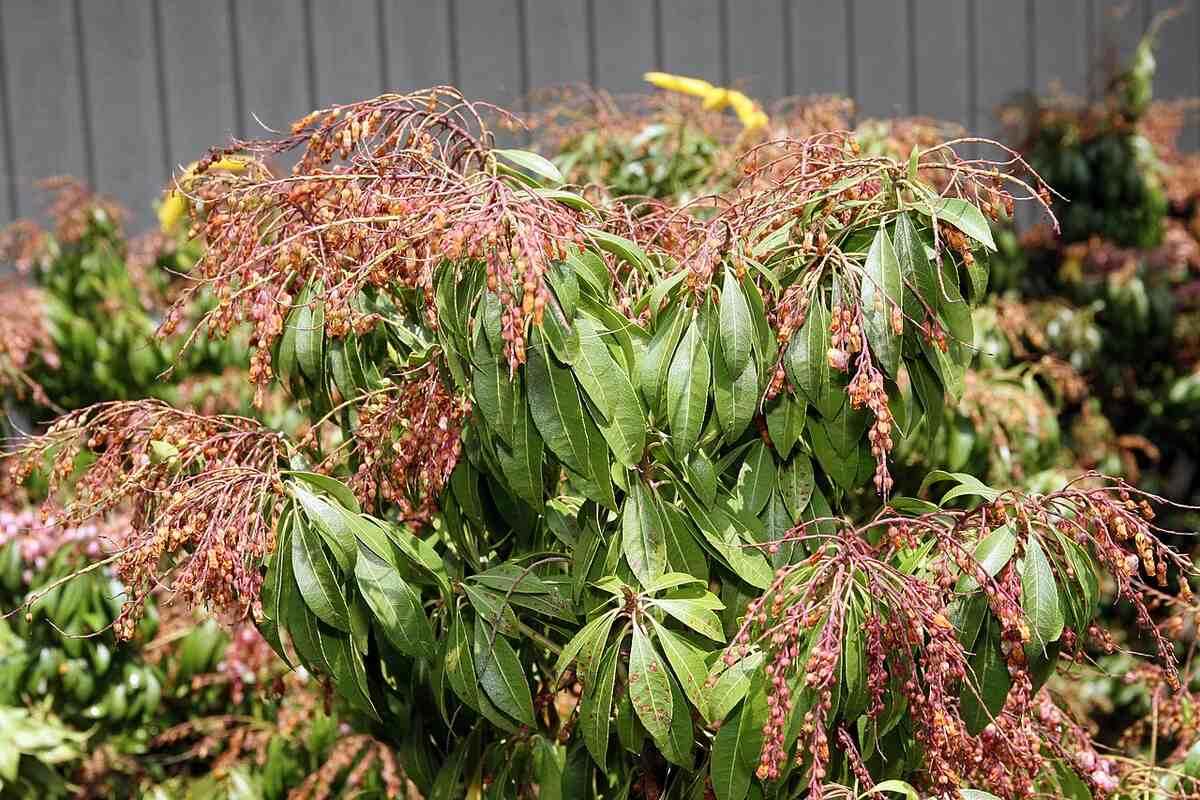
Considering adding flowering shrubs to liven up your landscape? We’ve compiled a list that checks all your boxes. Deer resistant? Attracts pollinators? Four-season color? Yes, this list has them all. These 10 flowering shrubs are perfect for making your landscape pop!
- 10 Best Flowering Shrubs for Your Yard
- 1. Best for Classic Beauty: Azalea
- 2. Best for Late-Blooming Flowers: Blue Chiffon Rose of Sharon
- 3. Best Low-Maintenance Shrub: Bridal Wreath Spirea
- 4. Best for Fragrant Gardens: California Sweetshrub
- 5. Best for Small Gardens: Dwarf Fothergilla
- 6. Best for Early Blooming Flowers: Lily-of-the-Valley Shrub
- 7. Best for Sensory Gardens: Mock Orange
- 8. Best for Statement Displays: Oakleaf Hydrangea
- 9. Best for Winter Interest: Red-Barked Dogwood
- 10. Best for Hummingbird Gardens: Weigela
- FAQ About Flowering Shrubs
- When to Call a Professional
10 Best Flowering Shrubs for Your Yard
Before you jump into a flowering shrub buying frenzy, check the USDA zone requirements, growth habits, sun tolerance, and other characteristics. This will help ensure a full-blooming, healthy shrub for many seasons to come.
1. Best for Classic Beauty: Azalea
Rhododendrons
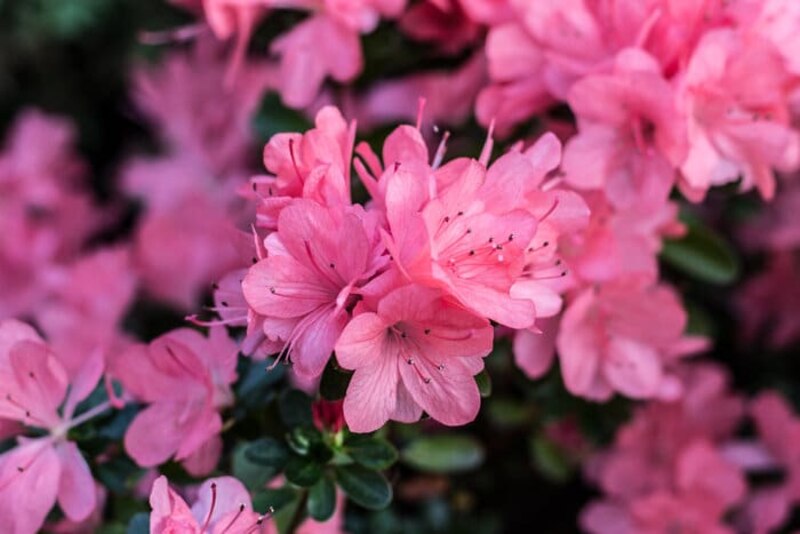
Photo credit: Mileniumphoto / Shutterstock
Azaleas, a perfect flowering shrub for historic garden design, add a sense of splendor to any landscape. Rhododendrons are flowering shrubs that work best in areas with partial shade. There are many cultivars to choose from, including North American natives and hybrid, reblooming varieties.
These classic spring beauties are great for borders, grouped plantings, and as a focal point in the yard. Healthy, well-established azaleas in the right location do well with little interference. Azaleas attract bees, are not susceptible to rabbit damage, and are poisonous if any part of the plant is eaten.
Flowers: Beautiful showy spring blooms in white, pink, purple, and peach.
Foliage: Choose from deciduous or evergreen flowering shrubs. In some azaleas, the glossy-green leaves turn color in the fall, so you get multi-season color.
Growth habit: 6-10 feet tall, 5-8 feet wide. Azaleas have an upright, loose habit.
- Hardiness zone: 4-8
- Colors: Flower colors in pink, lavender, red, white, peach, orange
- Sun tolerance: Partial shade; the direct sun can burn leaves
- Drought tolerance: High once established
- Soil type: Rich and high in organic matter, slightly acidic, good drainage
- Prune: Trim after the blooming season in the spring.
- Water: Water weekly to keep the soil moist but not too wet.
- When to plant: Fall or early spring
2. Best for Late-Blooming Flowers: Blue Chiffon Rose of Sharon
Hibiscus syriacus
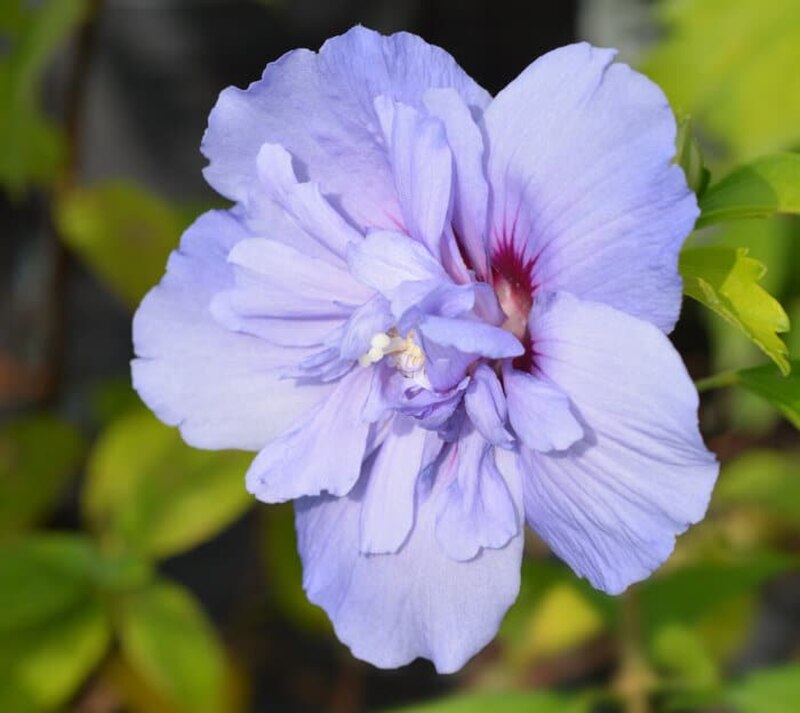
Photo credit: Nahhana / Shutterstock
Large, with a tropical look and abundant purple blooms, the Blue Chiffon Rose of Sharon is an excellent flowering shrub for pollinator gardens and butterfly gardens. Expect 2- to 4-inch flowers with five crepe-textured petals in late summer through fall.
Blue Chiffon Rose of Sharon is relatively low-maintenance, doesn’t need much pruning, and tolerates a range of soil types and pH levels. This flowering shrub has some resistance to salt and deer.
Flowers: Late summer brings enormous, luxuriant blossoms in purples and deep chiffon blue.
Foliage: Deciduous. In the late spring, the leaves are medium to dark green. In autumn, they turn yellow and fall off.
Growth habit: 8-10 feet tall, 6-10 feet wide. It grows erect with a spreading habit and is useful in hedges, groupings, and shrub borders.
- Hardiness zone: 5-9
- Colors: Purple/lavender, chiffon blue
- Sun tolerance: Full sun to part shade
- Drought tolerance: High once established
- Soil type: Variable, well-draining, moist
- Prune: Late winter or early spring
- Water: Prefers moderate moisture. Yellow leaves can indicate overwatering.
- When to plant: Spring or fall
3. Best Low-Maintenance Shrub: Bridal Wreath Spirea
Spiraea prunifolia
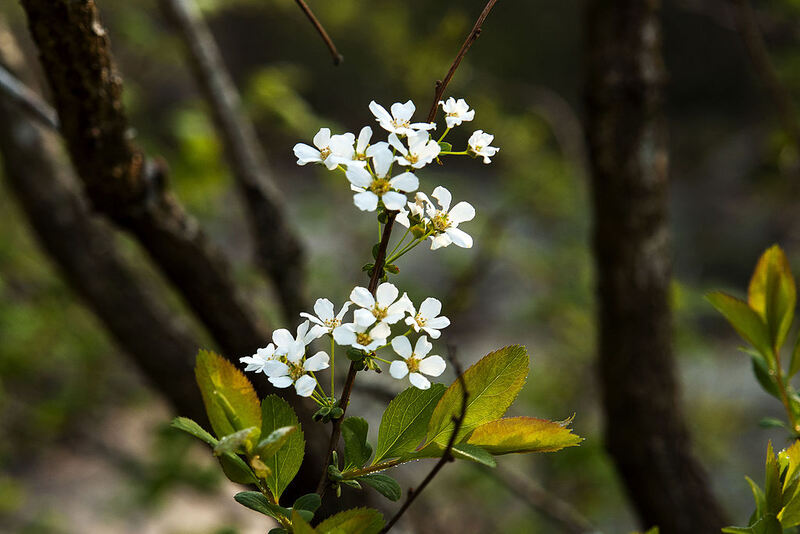
Photo Credit: 영철 이 / Wikimedia Commons / CC BY-SA 2.0
Bridal wreath spirea is a woody, spring-blooming deciduous shrub, great for novice gardeners since it doesn’t need much attention. Spiraea prunifolia thrives in most soils, is drought tolerant, and requires little attention, once it’s established. Spirea Bridal Wreath is a low-maintenance must-have classic in any landscape.
Bridal wreath spirea shrubs, with their beautiful, changing fall leaves and vibrant spring flowers, are great for borders, low hedges, and filler shrubs in the back of your perennial garden beds. Spiraea prunifolia is a robust shrub that attracts bees and butterflies and is resistant to deer.
Flowers: Early spring double white blossoms cover bare branches
Foliage: Deciduous. Delicately serrated leaves emerge in deep green, lime, gold, and blue hues, with some species putting on a spectacular fall show.
Growth habit: 4-8 feet tall, 4 to 8 feet wide with arching branches
- Hardiness zone: 5-8
- Colors: White
- Sun tolerance: Full sun for the best flower show, tolerates partial shade
- Drought tolerance: Low to moderate once established
- Soil type: Well-drained and neutral to slightly acidic
- Prune: Spring bloomers are clipped immediately after the flowers are gone.
- Water: Keep the soil moist, but not waterlogged. Water deeply but infrequently to develop healthy, strong roots.
- When to plant: Spring or fall
4. Best for Fragrant Gardens: California Sweetshrub
Calycanthus occidentalis
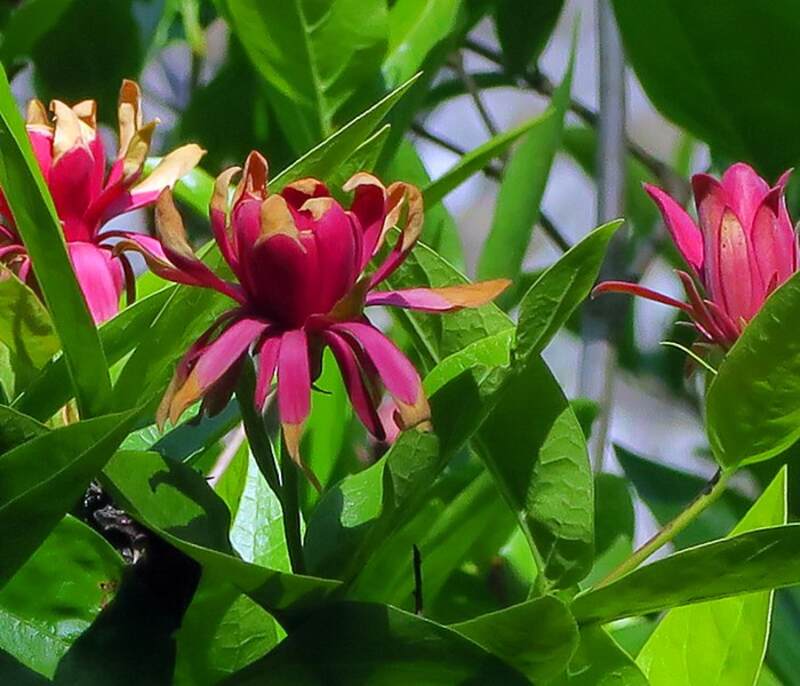
Photo Credit: John Rusk / Flickr / CC BY 2.0
The California sweetshrub has fragrant-smelling flowers that bloom from May through July. Depending on the cultivar (or the nose), the aroma varies from spicy to sweet to fruity. California Sweetshrub is ideal for fragrant or butterfly gardens, hedges, walkways, and in wooded areas.
The remarkable flowers remain for weeks in early summer, blossoming for the majority of the season in temperate climates. California Sweetshrub is a deer-resistant native of the Sierra Nevadas, is relatively low-maintenance, and tolerates most soil types.
Flowers: Big, distinctive red flowers with a spicy or sweet, fruity aroma
Foliage: Deciduous. In the fall, leaves turn from deep green to a vibrant yellow before falling
Growth habit: 3-9 feet high, 6-12 feet wide, with a rounded form
- Hardiness zone: 6-9
- Colors: Burgundy, wine-red
- Sun tolerance: Full sun to partial shade
- Drought tolerance: Low, prefers moist soils
- Soil type: Slightly acidic, tolerates a wide variety of soil types, well-drained
- Prune: In late summer after the flowering season
- Water: Prefers moderate moisture
- When to plant: Fall or winter
5. Best for Small Gardens: Dwarf Fothergilla
Fothergilla gardenii
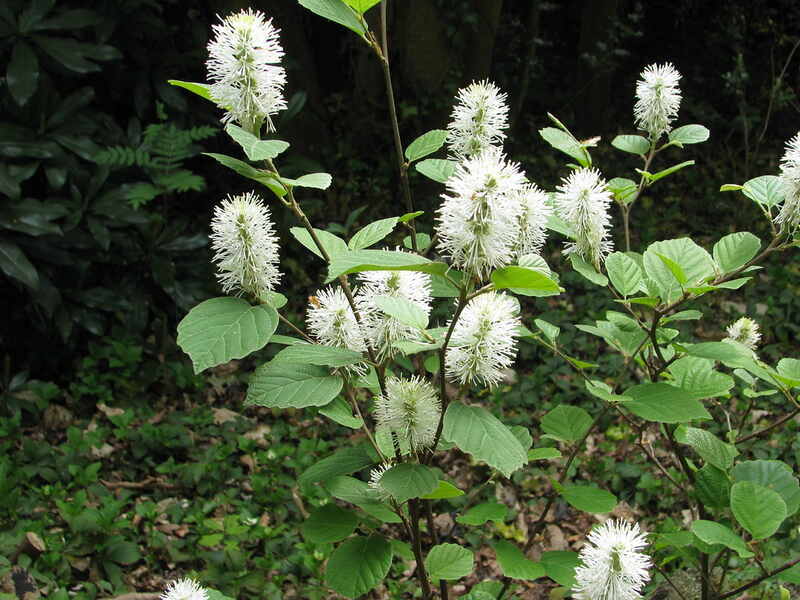
Photo credit: peganum / Flickr / CC BY-SA 2.0
This dwarf flowering shrub puts out a riot of white bottle-brush flowers in the spring and brilliant fall foliage, offering multi-season color and interest. Dwarf fothergilla is compact and low-growing with spreading branches, making it perfect for small gardens.
Dwarf fothergilla is native to the southeastern United States and is rarely affected by pests or disease. It deals well with challenging soil conditions like compressed and wet soil and is deer-resistant. Pollinators and songbirds love dwarf fothergilla.
Flowers: In spring, puts out white bottle-brush flowers. This flowering shrub works well for sensory gardens, as its flowers smell like honey and have an interesting texture.
Foliage: Deciduous. In summer, leaves are a bluish-green tint, and in fall, turn yellow, red, and orange.
Growth habit: 3-6 feet tall, 2-6 feet wide, making it suitable for small or urban gardens and yards
- Hardiness zone: 5-8
- Color: White
- Sun tolerance: Full sun to partial shade or dappled sunlight
- Drought tolerance: Good tolerance once established
- Soil type: Prefers good drainage and thrives in most soil types
- Prune: If the shrub has dead, broken, or crossed branches, cut it once the leaves have fallen off in the wintertime.
- Water: Weekly to maintain moist soil
- When to plant: Early fall or early spring, depending on your hardiness zone
6. Best for Early Blooming Flowers: Lily-of-the-Valley Shrub
Pieris japonica
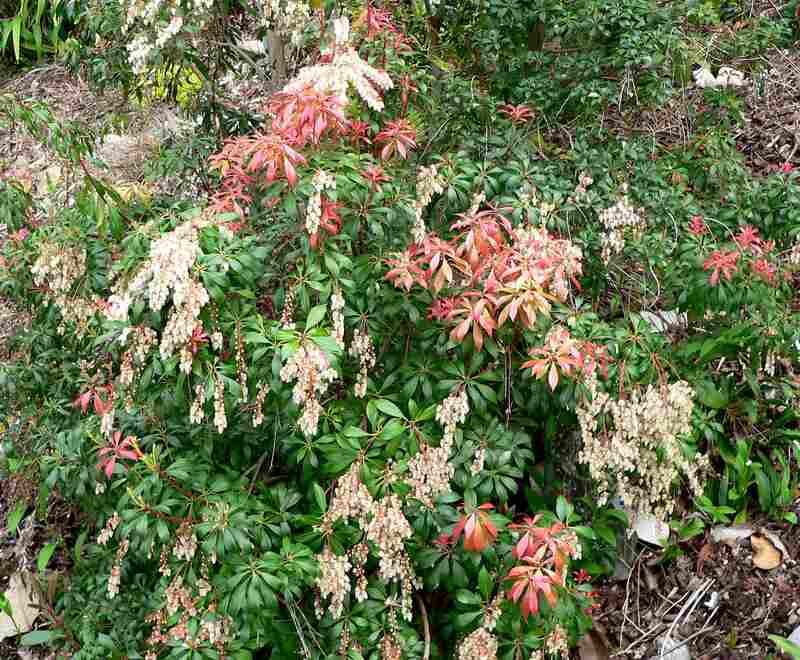
Photo credit: Stan Shebs / Wikimedia Commons / CC BY-SA 3.0
The cascading, bell-shaped flowers of this stunning early spring flowering shrub are reminiscent of the perennial lily of the valley flower. Native to eastern China and Japan, Pieris japonica are deer resistant and ideal for rock gardens, foundation plantings, and woodland boundaries.
Sometimes called Japanese andromeda, andromeda, and Japanese pieris, Pieris in Greek mythology is the name for one of the inspirational Muses. Pieris japonica grows slowly, and the flowers and leaves are highly toxic to people and animals.
Flowers: Flower buds form in the fall and winter and mature into lovely white urn-shaped clusters in early spring.
Foliage: Evergreen shrub. Tough, glossy green leaves. New leaves are purple or bronze-red.
Growth habit: 9-13 feet tall, 4-8 feet wide.
- Hardiness zone: 4-8
- Colors: Pink, white, deep red
- Sun tolerance: Full sun to part shade, likes filtered light
- Drought tolerance: Low, prefers moist soils
- Soil type: Slightly acidic, rich organic matter, moist, well-draining
- Prune: After flowering in mid-spring
- Water: Average watering of about once a week
- When to plant: Best with late fall planting. If planted in spring, the soil must be moist.
7. Best for Sensory Gardens: Mock Orange
Philadelphus coronarius
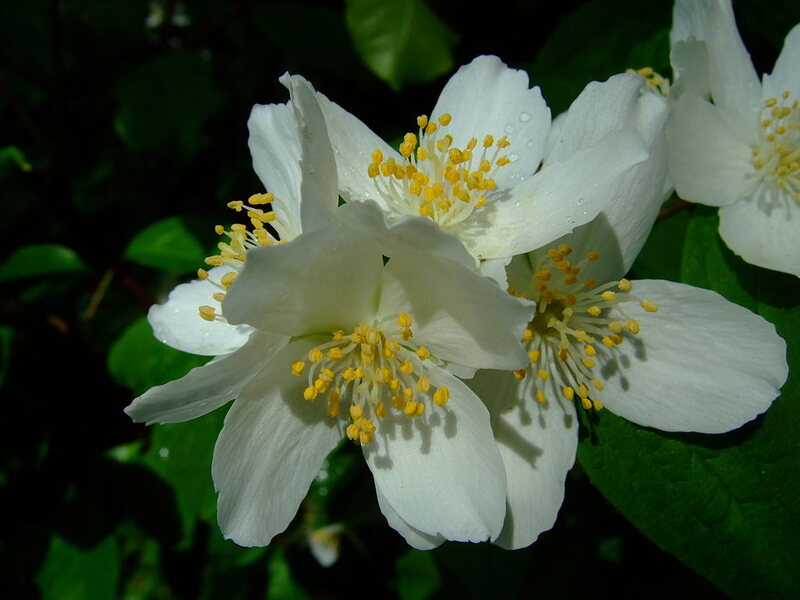
Photo Credit: Aiwok / Wikimedia Commons / CC BY-SA 2.0
Mock orange receives its name from the delightful orangey aroma that attracts both pollinators and people, making this plant perfect for a sensory garden. If you simply want to add a fragrant shrub to your landscape, plant mock orange next to a patio or sitting area to enjoy its scented blooms in late spring.
The aroma of mock orange shrubs is a big attraction, but not all types are equally scented. The best time to buy is while the shrub is in bloom at the garden center, so you can smell it before you invest.
Flowers: Snow-white blooms with four petals and a pale yellow center bloom in late May or early June.
Foliage: Deciduous. The oval leaves are light green in springtime and turn golden in fall.
Growth habit: 10-12 feet tall, 8-10 feet wide. Fast-growing, with a wealth of highly aromatic, pure white flowers in late spring/early summer.
- Hardiness zone: Hardy in zones 4 to 8
- Colors: White
- Sun tolerance: Full sun to partial shade
- Drought tolerance: High, but a little extra water in drought helps
- Soil type: Acidic to neutral; moist with good drainage; thrives in most soil types
- Prune: Regular modest pruning immediately after it flowers for a thicker, fuller look. Cut the oldest branches to the ground every few years.
- Water: Water weekly with about 1-inch of water after planting; drought-tolerant once established
- When to plant: Early fall is best but OK in spring
8. Best for Statement Displays: Oakleaf Hydrangea
Hydrangea quercifolia
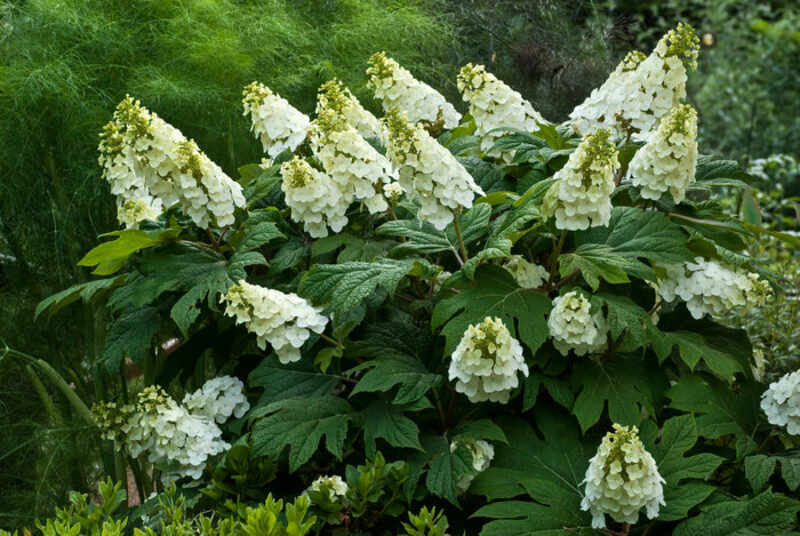
Photo credit: Gerry Bishop / Shutterstock
No list of the best flowering shrubs would be complete without this dramatic North American native. Oakleaf hydrangeas are a homeowner favorite for many reasons: They’re easy to grow, generally hardy once established, and erupt in showy, pyramid-shaped clusters of white flowers in late spring to summer.
During the growing season, it displays leathery, dark green foliage but turns deep red, orange, and rich mahogany in the fall. This flowering shrub is low-maintenance and lovely in pollinator gardens. It attracts birds, butterflies, and pollinators and is mildly toxic.
Flowers: Hydrangea quercifolia blooms from late spring through the summer in pyramid-shaped clusters of white flowers that fade to pink.
Foliage: Deciduous. Dark green and leathery leaves turn deep red, orange, and rich mahogany in the fall.
Growth habit: 4-8 feet tall, 4-10 feet wide, Has an irregular, rounded shape, grows from. Mildly toxic.
- Hardiness zone: 5-9
- Color: White, cream, pink, lavender
- Sun tolerance: Full sun to partial shade
- Drought tolerance: Good once well-established
- Soil type: Slightly acidic, well-drained, organic-rich
- Prune: Late fall, early spring
- Water: As needed or weekly, keep moist if possible
- When to plant: In the spring, when safe from frost
9. Best for Winter Interest: Red-Barked Dogwood
Cornus alba
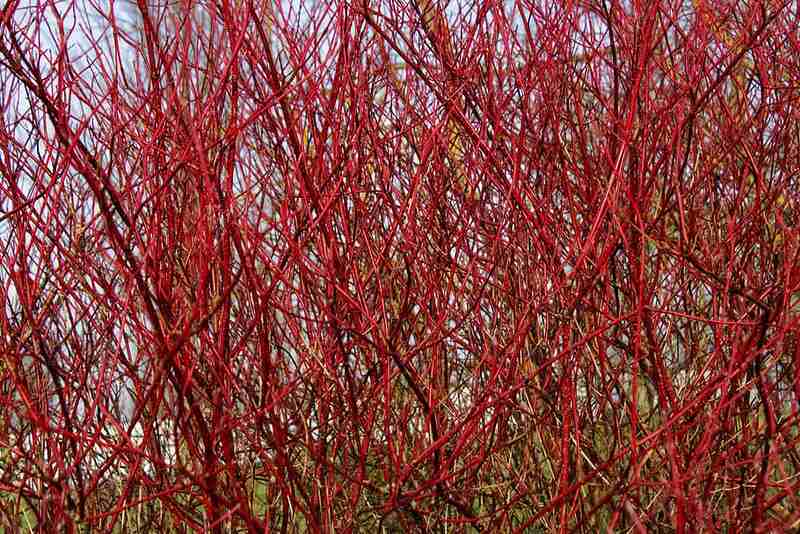
Photo credit: pxfuel
Red-barked dogwood is a beautiful flowering shrub that provides color and texture in all four seasons, but especially in winter. After the leaves fall, you’ll get a showy display of vivid red bark against your winter backdrop. Early in the year, during the growing season, its foliage is yellow-green or variegated with creamy edges.
In addition to its red winter bark and green or variegated foliage during the warm months, in spring, tiny bunches of white flowers come out, followed by a white or bluish drupe in the summer.
Resistant to deer, rabbits, and erosion, the red-barked dogwood attracts bees, butterflies, pollinators, and songbirds. It’s generally cold hardy with a slow growth rate.
Flowers: White flowers in spring. White or bluish drupe in the summer.
Foliage: Deciduous. Multi-hued leaves in yellow-green with creamy edges.
Growth habit: 8-10 feet tall, 5-10 feet wide
- Hardiness zone: 3-7
- Color: Red bark, white flowers
- Sun tolerance: Full sun to partial shade
- Drought tolerance: Low, prefers moist soils
- Soil type: From clay to sand, slightly acidic or alkaline, moist, good drainage
- Prune: Late winter or early spring
- Water: Keep moist in dry weather; can tolerate intermittent dry and wet spells
- When to plant: Spring
10. Best for Hummingbird Gardens: Weigela
Weigela florida
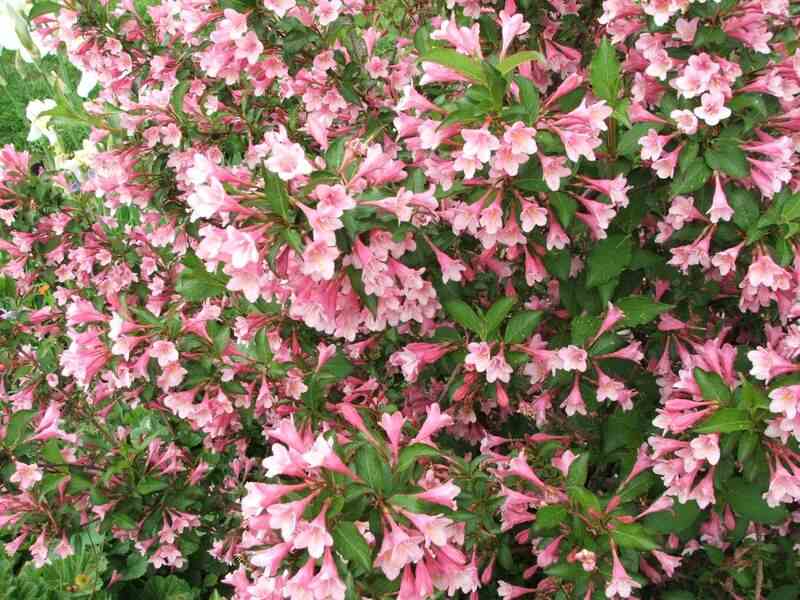
Photo Credit: Opiola Jerzy / Wikimedia Commons / CC BY-SA 2.5
Weigela (why-JEE-la or WAY-gehl-a) has pink, crimson, or white flowers that make a stunning background and attract hummingbirds. Its green foliage is covered with these tube-shaped flowers in spring, and it puts out a second, less profuse, burst of blooms in summer.
From late spring to summer, hummingbirds and butterflies love the stunning tubular blossoms of this Asia native. Those looking for privacy in their yard may opt to plant a row of weigela to form a hedge for deer-resistant summertime seclusion. They work wonders as a privacy screen, hiding ugly features in the landscape, and under windows.
Flowers: Blooms in the spring with elegant, tube-shaped pink flowers.
Foliage: Deciduous. The leaves are 2 to 6 inches long, elliptical with a slightly serrated edge, and occasionally shiny. Some leaf tints are green, gold, multicolored, red, or dark purple.
Growth habit: 6-10 feet tall, 9-12 feet wide. Cultivars include curving, upright, mound, or spreading natures that can grow up to 10 feet tall and 12 feet wide.
- Hardiness zone: 4-8
- Colors: Various shades of pink, red and white
- Sun tolerance: Full sun or partial shade, flowers best in full sun
- Drought tolerance: Very good once established
- Soil type: Prefers acidic, moist soil with good drainage, clay tolerant
- Prune: Not necessary, but perform soon after flowering if you want to prune
- Water: Water consistently and frequently until established. Then, only during intense heat or a long drought.
- When to plant: Best early spring or late fall
When you’ve planted your flowering bushes and your landscape is popping with color, sit back and watch the show as butterflies, bees, and hummingbirds swing by to check out your yard work.
FAQ About Flowering Shrubs
Hydrangeas, butterfly bushes, new reblooming lilac, reblooming azalea, spirea, and shrub roses are good choices. Many of them have notably prolonged flowering times or three-season appeal, providing something to see in spring, summer, and fall.
Trees and shrubs that grow too close to a house can send down roots that cause foundation problems. along with water and sewer lines. You may have to remove roots if you plant ones with invasive roots too close to your home.
Plant bare-root shrubs in early spring, before bud break. Balled, burlapped, and container-grown shrubs can be planted virtually any time of year, but spring or fall planting is ideal.
Shrubs should be grown in mulched beds if possible. Mulch retains moisture, lowers soil temperatures, and keeps weeds out, resulting in strong root systems
When to Call a Professional
You can see that adding a flowering shrub or two to your landscape can make it stand out in the neighborhood. Go ahead, explore what’s out there, and design the yard of your dreams!
If you need help with your yard or shrub care, LawnStarter’s landscape pros are just a click or a quick call away.
Main Image Credit: David J. Stang / Wikimedia Commons / CC BY-SA 4.0